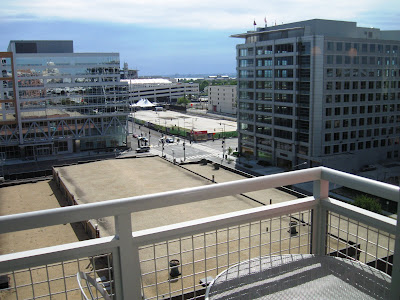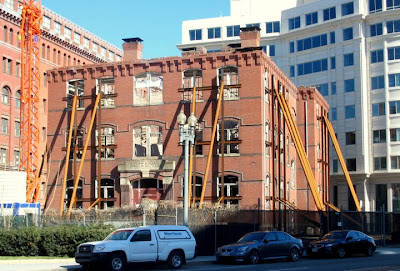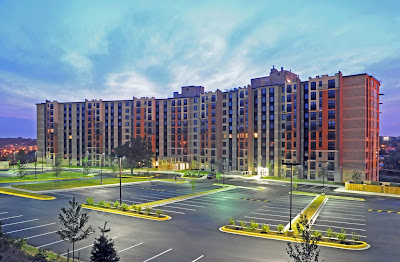 The Cohen Companies’ Velocity Condos, near the SE Navy Yard Metro and Nationals Stadium, hopes to entice buyers with their October 3rd and 4th "Grand Opening" event to celebrate completion of construction.
The Cohen Companies’ Velocity Condos, near the SE Navy Yard Metro and Nationals Stadium, hopes to entice buyers with their October 3rd and 4th "Grand Opening" event to celebrate completion of construction. Developers worked with ADC builders to create a condominium complex that promises to give on-the-go DC-types a taste of “downtown Manhattan in the middle of DC.” Boasting standard "luxury" features like stainless steel and granite, Velocity hopes to entice very patient buyers to invest in the Capitol Riverfront's only new condo for sale.
Developers worked with ADC builders to create a condominium complex that promises to give on-the-go DC-types a taste of “downtown Manhattan in the middle of DC.” Boasting standard "luxury" features like stainless steel and granite, Velocity hopes to entice very patient buyers to invest in the Capitol Riverfront's only new condo for sale.
The 200-unit, 14-story Velocity features standard amenities like the 24-hour concierge service and underground garage parking. But the sales team hopes other touches like Velocity’s rooftop pool deck, private balconies, full-height granite backsplashes, and built-in lazy Susans will go a long way toward separating these units from the pack. Residents may even have a manicured central courtyard to look forward to next year, if plans coalesce for construction of an identical, 200-unit, Phase 2 condominium next door; but that looks unlikely, and the lot is still vacant.
Sales Manager Vicki Johnston explains that some of the condo's finer details like extra walk-in storage space and deeper-than-standard bath tubs can be attributed to a woman’s touch as they were envisioned “by the amazing, completely female design team at GTM Architects.” And according to Johnston, Southeast DC condo shoppers might be "surprised" to learn these are “the only condos in the ballpark area. All the other units around here are co-ops and rental units.” Of course that may be by default - since JPI's three nearby condo projects turned rental thanks to the market (JPI fizzled as well), as did Faison's Onyx, all of which are now substantially leased (ok, thanks to giving away months of free rent). Then there's Velocity. Since beginning sales in 2007, only 58 of the available 200 units have been purchased—so it might be premature to rule out rental units in Velocity's future. Despite these modest sales numbers, Johnston sounds confident that the right potential buyer could rake in big bucks on resale, assuming he or she is “willing to hold out for a little while.”
Since beginning sales in 2007, only 58 of the available 200 units have been purchased—so it might be premature to rule out rental units in Velocity's future. Despite these modest sales numbers, Johnston sounds confident that the right potential buyer could rake in big bucks on resale, assuming he or she is “willing to hold out for a little while.”
 Prices for Velocity units begin at $317,900 ($295 condo fee) for a 644 s.f. studio and run the gamut up to $784,900 ($683 condo fee) for a 1,492 s.f. 2BR/2BA/Den combo. The one bedroom, two bath, den condo has been the most popular among buyers thus far and runs $483,900 ($488 condo fee).
If you are willing to take the risk while the units are still plentiful, the rewards include a $1,000 credit towards customizing your own closets and a free parking space worth $35,000 (the garage holds an unusually high ratio of 1.5 spaces for condo).
Now, it’s only that small matter of the neighborhood building up around it.
Prices for Velocity units begin at $317,900 ($295 condo fee) for a 644 s.f. studio and run the gamut up to $784,900 ($683 condo fee) for a 1,492 s.f. 2BR/2BA/Den combo. The one bedroom, two bath, den condo has been the most popular among buyers thus far and runs $483,900 ($488 condo fee).
If you are willing to take the risk while the units are still plentiful, the rewards include a $1,000 credit towards customizing your own closets and a free parking space worth $35,000 (the garage holds an unusually high ratio of 1.5 spaces for condo).
Now, it’s only that small matter of the neighborhood building up around it.
 Since beginning sales in 2007, only 58 of the available 200 units have been purchased—so it might be premature to rule out rental units in Velocity's future. Despite these modest sales numbers, Johnston sounds confident that the right potential buyer could rake in big bucks on resale, assuming he or she is “willing to hold out for a little while.”
Since beginning sales in 2007, only 58 of the available 200 units have been purchased—so it might be premature to rule out rental units in Velocity's future. Despite these modest sales numbers, Johnston sounds confident that the right potential buyer could rake in big bucks on resale, assuming he or she is “willing to hold out for a little while.”
 Prices for Velocity units begin at $317,900 ($295 condo fee) for a 644 s.f. studio and run the gamut up to $784,900 ($683 condo fee) for a 1,492 s.f. 2BR/2BA/Den combo. The one bedroom, two bath, den condo has been the most popular among buyers thus far and runs $483,900 ($488 condo fee).
If you are willing to take the risk while the units are still plentiful, the rewards include a $1,000 credit towards customizing your own closets and a free parking space worth $35,000 (the garage holds an unusually high ratio of 1.5 spaces for condo).
Now, it’s only that small matter of the neighborhood building up around it.
Prices for Velocity units begin at $317,900 ($295 condo fee) for a 644 s.f. studio and run the gamut up to $784,900 ($683 condo fee) for a 1,492 s.f. 2BR/2BA/Den combo. The one bedroom, two bath, den condo has been the most popular among buyers thus far and runs $483,900 ($488 condo fee).
If you are willing to take the risk while the units are still plentiful, the rewards include a $1,000 credit towards customizing your own closets and a free parking space worth $35,000 (the garage holds an unusually high ratio of 1.5 spaces for condo).
Now, it’s only that small matter of the neighborhood building up around it. District of Columbia retail and real estate development news






















 Following the long term loss of the library in 2005, everything has gone according to plan, excepting, that is, the lack of plan for a new library, the city's belated selection of a developer for the site, the public outcry over the city's selection thereof,
Following the long term loss of the library in 2005, everything has gone according to plan, excepting, that is, the lack of plan for a new library, the city's belated selection of a developer for the site, the public outcry over the city's selection thereof, 

















 market is Harvard Lofts, a 12-unit condo on the south side of Columbia Heights, located at 1466 Harvard Street. With construction recently completed in May of 2009, Harvard Lofts opened for sale on Saturday for the first time, DCMud provides a first look.
market is Harvard Lofts, a 12-unit condo on the south side of Columbia Heights, located at 1466 Harvard Street. With construction recently completed in May of 2009, Harvard Lofts opened for sale on Saturday for the first time, DCMud provides a first look.
 views to the south, you choose.
views to the south, you choose. The penthouse level features two small one-bedroom units with private terraces, and two 2-bed plus den penthouses, each with several large private terraces at $875,000 each. The developer, Harvard Loft, LLC, notes that pains were taken to make the building green, from choice of materials to efficient appliances and innovative lighting that is both efficient and bright, though no LEED certification was achieved. The condos are open on weekends and by appointment.
The penthouse level features two small one-bedroom units with private terraces, and two 2-bed plus den penthouses, each with several large private terraces at $875,000 each. The developer, Harvard Loft, LLC, notes that pains were taken to make the building green, from choice of materials to efficient appliances and innovative lighting that is both efficient and bright, though no LEED certification was achieved. The condos are open on weekends and by appointment.




